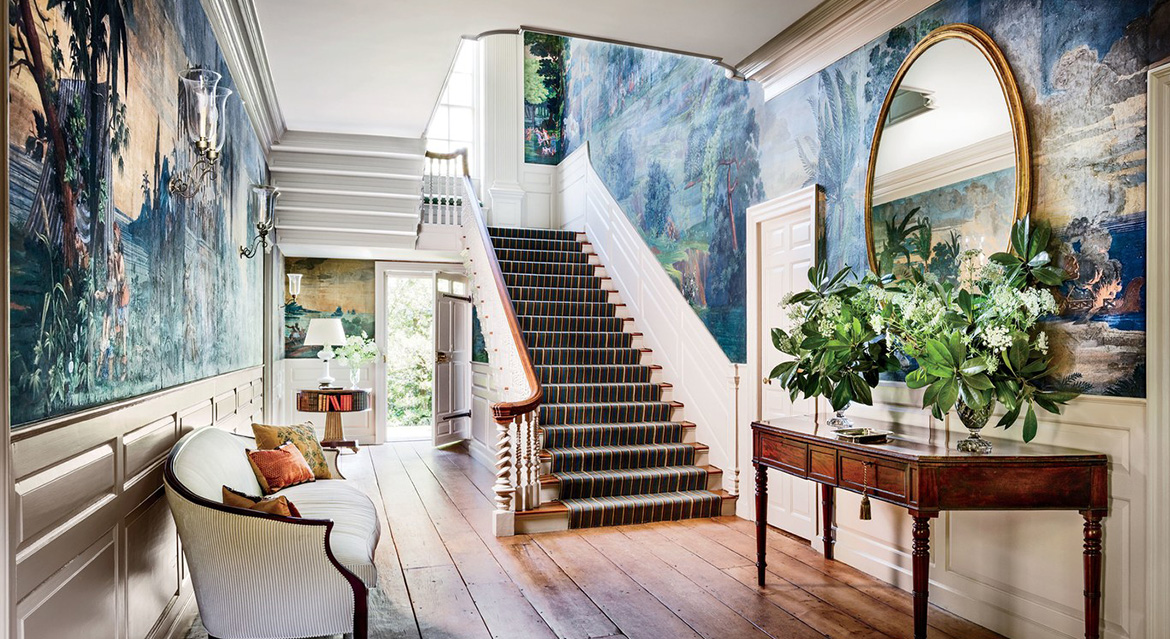This article originally appeared in the February 2017 issue of Architectural Digest
Back in November 1937, The Washington Post ran a story recounting how six U.S. senators, the British ambassador, and other high-profile guests attending noted D.C. couple Miriam and George Maurice Morris’s housewarming at their historic home, known as the Lindens, “had to pinch themselves . . . to be sure they hadn’t stepped backward 200 years.” The hostess greeted everyone in a damask hoopskirt, and the refreshments were made from Colonial recipes. Junior League guides recited the provenances of the period furnishings. Over the next 45 years Miriam would welcome to the dwelling some 50,000 visitors, from First Ladies to scholars. Whether amazed or bemused, they surely never forgot the couple’s overwhelming passion for the past.
A fertilizer heiress and a lawyer, the Morrises collected 17th- and early-18th-century Americana with discernment, and to complement their treasures they agreed that only an authentic Colonial house would do. Unfortunately nothing in Washington, D.C.—which was founded in 1790—fit the bill, so they scoured the East Coast for a suitable landmark that could be relocated. In 1934 they zeroed in on the Lindens, a 1750s Georgian masterpiece in Danvers, Massachusetts. One of the property’s owners at the time, legendary antiques dealer Israel Sack, had sold off the paneled parlor to what is now the Nelson-Atkins Museum of Art in Kansas City; demolition threatened what remained. The Morrises snapped up the three-story house for about $13,000 (approximately $227,000 today), and under the supervision of Walter Macomber, Colonial Williamsburg’s first resident architect, the frame structure was dismantled nail by nail and carted to Washington on six railroad freight cars to be rebuilt in the posh Kalorama neighborhood. As for the parlor, Sack had it replicated as part of the sales agreement.

Surprisingly, the damage in transit amounted to little more than a few shattered windowpanes. Especially notable was the survival of three complete sets of Dufour et Leroy scenic wallpapers, which artisans steamed off the two-story stair hall and rehung once the Lindens reached its new home. The Morrises waived their usual collecting rules for these 19th-century French rarities, and they also allowed Macomber to strengthen the structure with steel beams and to tuck modern bathrooms for them and their three children into closets once used for powdering wigs. Glaring anachronisms were concealed: Fake book spines masked the radios, and antique boxes hid the telephones.
Following Miriam’s death in 1982 (her husband had predeceased her decades earlier), Christie’s dispersed all but one of the couple’s prize antiques: the eight-bedroom mansion itself. When the present owner, who acquired the Lindens seven years ago from a subsequent resident, first showed the unfurnished rooms to interior designer Mariette Himes Gomez, the decorator recalls, “He proudly pointed out that this is the oldest house in Washington.” Her role promised to be a delicate balancing act. While her client cherished the structure’s legacy, she observes, “he did not want it to feel like a house museum. He wanted it to feel like home.”
That being said, Gomez channeled some Morris spirit when she addressed the subcontractors. “I told those guys, ‘Respect this house!’ That became my mantra, too.” Wide-plank pine floors, some of which had been painted ebony, were patiently hand-sanded and then burnished to a natural patina. “The floors and exquisitely detailed walls may be the most beautiful things in this house,” says the designer, noting that the furnishings needed to defer to the elegant woodwork, from the double-cross paneled doors to the window seats she describes as “so chic.” Gomez adds, “You want people to notice all that, not some decorator’s one-upmanship.”

The wallpaper in the entrance hall struck a different, more romantic chord and provided important inspiration, too. “It’s the center of the universe here,” the designer says, “a whole world of culture and color.” The intricate scenes of ancient Greece and Peru (hundreds of separate blocks were used to create them) led Gomez to develop a rich yet low-key palette for the surrounding rooms. “Some historic colors look incredibly bright to us today, because they were meant to be seen by candlelight,” the designer says, “so I subtly adjusted their intensity.” She concocted a pale blue for the dining room to enhance its intimate atmosphere. In the library, walls painted a soft café au lait set a cozy mood attuned to the client’s love of reading. Persian carpets extend this tonal range with madder reds and shades of indigo.
Georgian furnishings anchor the rooms (Gomez bought numerous antiques in London), but modern-day comfort is preferred to curatorial strictures. Sleeping quarters are outfitted with contemporary beds with upholstered headboards, as opposed to the traditional canopied four-posters beloved by the Morrises. The swagged and fringed curtains, however, are “formal, to sympathize with the mantels and other woodwork,” Gomez says. In the dining room, meanwhile, an 18th-century portrait of a dour bewigged Scot is leavened by its reflection in glamorous 1930s Venetian mirrors.
Not long after the designer’s work was done, a neighbor knocked on the front door to say, “I have six Hepplewhite chairs that used to be in this house before it left Massachusetts. Would you like them?” Bills of sale verified the man’s story, and soon the chairs were carried down the street and into the dining room, where you can almost hear them sigh, “Home at last.”

This article originally appeared in the February 2017 issue of Architectural Digest.
